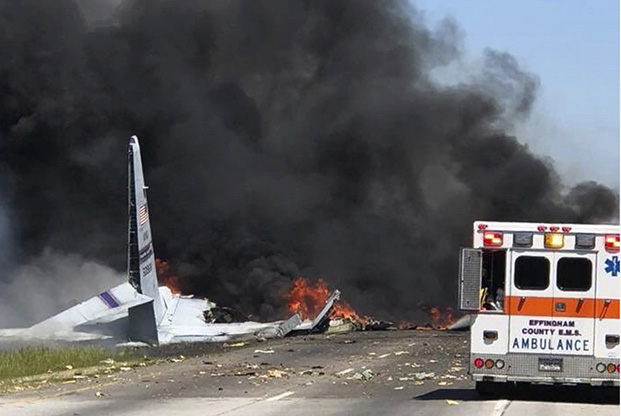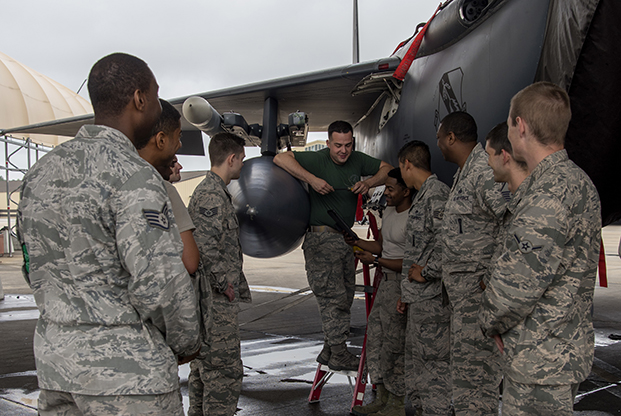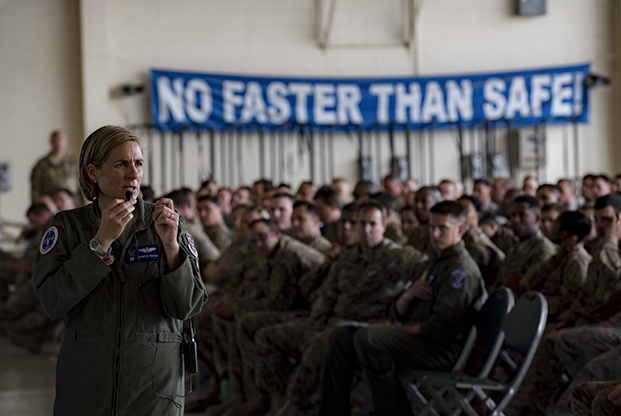
With the recent trend of deadly aircraft crashes, safety must become a No. 1 priority. This WC-130H from the Puerto Rico ANG crashed near Savannah, Ga., last May, killing nine. Photo: Int’l Assoc. of Fire Fighters 574 (Savannah)
Conflicting priorities and its own can-do ethos are challenging Air Force leaders to improve mission readiness without compromising safety.
A rash of accidents last winter and spring drove Chief of Staff Gen. David L. Goldfein to order a fleetwide stand-down. Commands used that time to dig into safety and operational concerns, concluding that ops tempo, stress, and a cultural aversion to ever say “no” had helped to increase stress and undermine the safety culture.
Yet no sooner had commands started talking of adding “white space” to pilots’ schedules, than a new challenge rattled the service: Defense Secretary Jim Mattis sounded the alarm over fighter aircraft readiness. Disturbed by mission-capable rates of just 49 percent for F-22s in 2017—and only slightly better at 55 percent for F-35s—Mattis ordered the Air Force and Navy to solve the problem. He wants rates to hit 80 percent as soon as possible.
So, once again, the pressure to execute and the need for more downtime are in a head-to-head competition.
Based on data collected from individual flying wings during the force-wide, day-long safety stand-downs, the September report found maintainers and aircrew believed their units suffered from:
- Stress resulting from a high operations tempo;
- Not enough time to train on basic flying;
- Pressure to accept risk due to a cultural insistence to always execute the mission;
- Decreased aircraft availability; and
- Complacency while performing routine tasks.
Now the situation is getting worse. More than a dozen F-22s were damaged when Hurricane Michael tore through Tyndall AFB, Fla., in October; while the Air Force was able to fly at least 30 F-22s out of Tyndall to safety, the remaining jets could not be made flightworthy in time—a real-world illustration of the airplanes’ troubled availability. Meanwhile, the Air Force also continues to struggle with a pilot shortage, along with a parallel shortage of experienced maintainers. While overall maintainer numbers have improved, it will take years to build back lost experience.
In an October report, the Government Accountability Office cited the way the Air Force organizes its F-22s and trains Raptor pilots as contributing to the jets’ low mission-capable rates. The report also found problems with Air Force F-35s, which it said suffer from sustainment challenges, repair backlogs, and shortages. The lack of spares meant the aircraft were unable to fly 22 percent of the time due to parts shortages throughout most of 2017.
The fleets of these two aircraft are already small, meaning a push for improved mission-capable rates will come on the backs of stressed aircraft.
“The Air Force will have to keep much of its existing force structure for decades to come,” said John H. Pendleton, director of defense capabilities and management at the GAO, in an Oct. 10 Senate Armed Services Readiness and Management Support Subcommittee hearing. “The priority needs to be rebuilding the readiness of the existing fleets certainly in the near-term.”
Pendleton said the Air Force has a steep climb ahead, but is making progress.
“They have taken several steps in the right direction,” he said. “Now it’s a matter of achieving results. Recovery won’t be easy or fast. It took a quarter- century for the Air Force to get here, so it may take a while to recover.”

CSAF Gen. David Goldfein directed a one-day operational safety review in May.Airmen at Seymour Johnson AFB, N.C., got instructions on how to safely arm a weapons system on an F-15E Strike Eagle during the review. Photo: A1C Shawna Keyes
PACE OF OPERATIONS
Goldfein ordered flying wings to take a one-day flying “stand-down” in the spring to discuss, review, and emphasize safety after a deadly series of accidents in 2017 and 2018 killed dozens of airmen and raised concerns that military aviation was in crisis.
The stand-down helped bring a renewed focus on the culture of safety, Goldfein said in September. “I want commanders to push themselves and their airmen to achieve high levels of readiness,” he said in an official release. But, “sometimes the right answer is to knock it off.”
Beginning May 21, wings stopped flying as air and ground crews gathered for all-calls and in operations offices. Maintainers and pilots sat side by side to discuss issues they thought contributed to mishaps, with most of the discussions focusing on similar themes.
“The review proved tremendously helpful as we continue to see both high levels of safety with intense and realistic training,” Goldfein said. “As air superiority is not an American birthright, our training must continue to be challenging and meaningful. But I also want commanders to have the decision authority to determine how far to push.”
The stand-down included specific topics for discussion and deadlines for conducting the safety review, but did not include an action plan for follow-up.
Wings and major commands weren’t required to report specific findings or explain planned changes, and no formal compilation of results was released.
For Air Mobility Command, the discussion was “invaluable” because airmen appreciated commanders “sitting down and having the conversation” on safety and the operations tempo they live with every day, AMC boss Gen. Maryanne Miller said. The command is looking to build more “white space” into airmen’s lives to reduce operations tempo, and airmen appreciated being heard, Miller said.
The discussion showed a “safety-minded consciousness” among airmen, Pacific Air Forces Deputy Commander Maj. Gen. Russell L. Mack told Air Force Magazine. While airmen face a high operations tempo, they are “all about making sure things are done effectively and safely. They know that, they drive to that,” he said.
After the review, however, the service has not as yet identified an all-force action plan (as of November) to address the situation, even as it comes under greater pressure to increase its readiness rates, which are keyed to flying hours.
For Air Combat Command, the review was an “opportunity to identify issues” that could affect the overall mission. ACC initiated no commandwide changes, said command spokesman Capt. Luke Nimmo.
Other changes across the Air Force meant to reduce stress on aircrew, such as reducing additional duties, revitalizing squadrons, and enhancing mission planning, had already been in the works before the stand-down.
From Fiscal 2008 to Fiscal 2018, the Air Force lost 84 airmen to crashes. Eighteen of those fatalities occurred in 2018, including nine when a Puerto Rico Air National Guard WC-130U crashed on a Savannah, Ga., highway on May 2. Crashes have continued since:
- Two T-38s crashed, one Aug. 17 near Vance AFB, Okla., with the pilots ejecting, and another Sept. 11 at Sheppard AFB, Texas.
- A T-6 crashed Sept. 18 near JBSA-Randolph, Texas, with the pilots able to eject.
- An F-22 skidded off the runway when landing gear failed during an emergency landing Oct. 10 at JB Elmendorf-Richardson, Alaska.

Col. Jennifer Short, 23rd Wing commander, addresses airmen at Moody AFB, Ga., during the one-day operational safety review on May 14. Photo: SrA. Daniel Snide
OVERSEAS CHALLENGES
While most of the wings affected by the stand-down were Stateside and able to fully stop their operations, others had to find workarounds. The 199th Fighter Squadron from JB Pearl Harbor-Hickam, Hawaii, was deployed to South Korea as a Theater Security Package and worked its stand-down into a break during an exercise. The unit’s “safety guys” walked the unit through recent F-22 accidents and led discussions on contributing factors, a 199th FS pilot said in a recent interview.
At the 432nd Wing at Creech AFB, Nev., the Air Force’s principal remotely piloted aircraft wing could not stand down the entire wing at once, Wing Commander Col. Julian C. Cheater said in a recent interview. Instead, the stand-down had to be held in phases.
One takeaway for his wing, Cheater said: RPA pilots and sensor operators are encouraged to raise their hands if they become too tired during a mission and hand off to someone else to continue. The decision to stop or continue is between the crew and the operational command in theater, instead of with higher command locally at Creech.
At the 374th Airlift Wing’s stand down at Yokota AB, Japan, maintainers and operators came together for an “open conversation about what everyone is seeing,” then-wing commander Col. Kenneth E. Moss said in a recent interview. He wanted help “identifying things leadership isn’t seeing or [is] not aware of because of the distance from the flight line.”
Moss said he learned so much that he ordered regular stand-downs, quarterly.
The 535th Airlift Squadron also at JB Pearl Harbor-Hickam, Hawaii, a C-17 unit responsible for long-distance airlift across the Pacific, identified problems driven by the vast expanses flights span in the region. Squadron commander Lt. Col. Chad Cisewski said in an interview long flights can end up meaning 24-hour workdays for aircrew. To mitigate risk, the squadron is giving crews more warning before missions to ensure they’re well rested and adding a fourth pilot to the current three-pilot minimum needed for a 24-hour mission.
“It’s kind of a tax on the squadron, a step above and beyond, but when we can do it, it’s absolutely worth it,” Cisewski said.
Goldfein said the stand-down accomplished its objective: to increase the awareness of safety issues.
Maj. Gen. John T. Rauch Jr., commander of the Air Force Safety Center, said the stand-down helped commanders identify concerns and flag those to higher-level commands. “This review gave commanders the opportunity and time to focus on ensuring operations were safe by identifying hazards that could lead to mishaps,” Rauch said in a release. Safety, he said, is ultimately about airmen taking care of airmen.